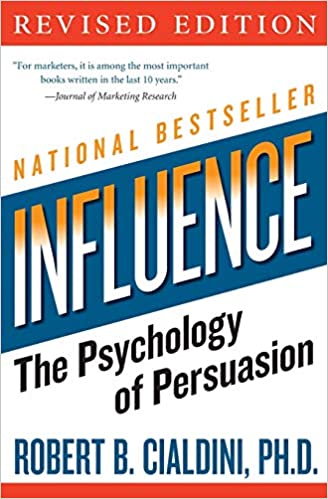If you want your superpower to be the ability to influence people, then stay tuned! The ability to be incredibly persuasive can be invaluable no matter where you work.
Contrary to popular belief, it’s not an innate skill. Anyone, as long as they learn the right steps, can be just as– if not more– persuasive.

Influence
by Robert Cialdini
⏱ 14 minutes reading time
🎧 Audio version available
Expect Refusal the First Time
Let’s start with a tried and true method of persuading people to say yes to a request. According to Stanford University, people are more likely to feel uncomfortable refusing someone repeatedly. That means they may not mind refusing the first time, but the second? That’s when you work your charm.
So, approach them first with a request you don’t mind them saying no to. Later on, approach them with a different request, perhaps one that involves less effort than the first. The person is likely to say yes to the second request because a) it takes less energy and b) they may harbor some guilt because they feel they let you down the first time and want to make up for it.
Use More Persuasive Words
The vocabulary you use when trying to convince someone of something matters a great deal, especially if you want them to do something for you. The trick is wording your request as if it’s not a request.
Being charming has a large role in this. When you’re talking to someone, a resume and your impressive accomplishments will only get you so far. People have to actually like what you’re saying in order to be influenced by you.
Let’s say you approach someone with a sales pitch, for example. And their answer is interested but not super enthused. It’s up to you to influence this decision. Ask them if they would instead consider something else or if they would be willing to consider this. Adding a certain willingness to your question dramatically increases the odds of a positive response. See, when you add this sort of phrasing, instead of focusing on a person’s preferences, you’re focusing on who they are as a person and their character.
Give Them Something to Gain
People are infinitely more likely to do something you want if your request is framed in such a way that shows them what they stand to gain.
This is negotiation 101. Make sure they feel like they’re profiting too.
The “But You Are Free” Method
The “But You Are Free” method is one that’s been tested in 42 psychology studies on over 22,000 people, and it works wonderfully. It’s a technique for being more persuasive and for doubling your chances of someone agreeing to what you want.
It goes like this: approach the person with your request, and end the sentence by telling them they should only do this if they want–as in they’re “free” to refuse. What this method does is indirectly show the person you’re trying to influence that you’re not trying to impose on them or threaten their ability to say no; instead, you are firmly reassuring them of their freedom of choice.
They end up feeling empowered and on your side. It’s best to use this method in moderation, lest you end up sounding passive aggressive.
Delivery is Everything
The way you deliver your request counts in how people are influenced by you and how they’ll respond. You want to speak fairly quickly and clearly. See, when you speak too slowly, or fumble for words, you’re hurting your own effect and giving the other person a chance to nit-pick your argument.
However, when you speak rather quickly– or find a healthy balance, you want to give the other enough time to hear you, but not enough to focus on nit-picking. Chances are that they’ll be too busy trying to process if they agree or not to interrupt you.
And at the end of the day, you’re perceived as more confident, which helps you seem more persuasive. You’re also perceived as knowledgeable, trustworthy, and charismatic. Even if they don’t realize why, people will want to get your approval.
Create a Sense of Loss and Urgency
Or to put it into more modern terms, create a sense of FOMO– aka, the fear of missing out. You might think putting a sense of urgency in your request would make it less appealing, but you are actually increasing your chances of influencing that person.
It’s a typical marketing scheme. For example, when a store offers limited sales and such, which pushes customers to hurry to buy these products before others get there first. This technique isn’t limited to selling products. You can apply this to your interactions where you need to convince someone to do something for you.
Let’s say you approach a co-worker with a request, help hurry their agreement by adding a time limit. This urgency may be the little push needed to help them reach a decision. This immediate need and a deadline at their heels add a certain– healthy– sense of guilt. Guilt, even a tiny amount of it that results from fear of letting someone down, can make people want to do the right thing.
Make It About Them
If you want to influence someone to do something for you, then the key may not be showing off your accomplishments or highlighting your education and career. A lot of people may not see those as enough of a reason to be influenced by you.
So, make it all about the person you’re in front of. People generally love it when they’re asked about themselves and what they want. The best influencers are the ones that start from here.
Making people feel important, praising them, remembering their interests, and generally chatting with them, goes a long way towards helping them connect with you and thus, being more easily influenced by you.
Remember Their Names
Persuasion 101? Remember the person’s name. Yes, it can be difficult to remember a person’s name when you first meet them, especially if you’re meeting with several new clients in a row.
Remembering the person’s name and casually slipping it into the conversation makes the person feel acknowledged and important. In the iconic, How to Win Friends and Influence People by Dale Carnegie, he says, “Remember that a person’s name is, to that person, the sweetest and most important sound in any language.”
Find Common Ground
You may lose your argument before you even get started if you start on polarizing ground. It’s important to find something in common with the person in order to help them relate to you.
Follow that by easing into the more difficult subject or request.
Assess How to Best Appeal to Them
When you approach someone with a request and for example, as a strategy, share a story to help them relate to you and want to help you; it works around 20% of the time. Why? Not all people respond the same way to an emotional approach.
Some will lap up a logical approach. You want to present them with an argument, goals, benefits, and try to appeal to their minds.
An emotional approach is when you connect your request or goal to the person and make the person feel connected enough to want to offer support.
Some people are in the middle. They won’t be influenced unless they see a cooperative appeal to the subject. That means approaching them in a manner that offers working together to reach a goal.
You can figure out which of these three methods to use after the following steps: assess the situation at hand, get to know your audience, and listen carefully. Listening can get you a home run. If you listen carefully, you could find out everything you need to know about that person’s character, needs, and desires.
If you want to influence people, you have to listen to all that’s being said and what’s left unsaid. So, when you respond, you make the other person feel seen and validated. If they feel ignored or brushed off, of course they won’t be positively influenced by you.
What Is Snapreads?

With the Snapreads app, you get the key insights from the best nonfiction books in minutes, not hours or days. Our experts transform these books into quick, memorable, easy-to-understand insights you can read when you have the time or listen to them on the go.
